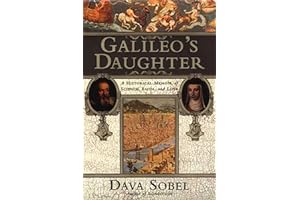One sentence summary:
A historical memoir exploring the complex relationship between science, faith, and love through the letters of Galileo Galilei and his daughter, Suor Maria Celeste.
Book genre:
Biography, History, Science, Religion
Main topic of the book:
The life and work of Galileo Galilei, his relationship with his daughter, and the societal and religious challenges he faced as a scientist during the 17th century.
Key ideas:
- The use of Galileo’s personal letters and correspondence with his daughter, Suor Maria Celeste, to humanize the scientific figure and provide insight into his personal life.
- The conflict between science and religion during the Renaissance and Baroque periods, as exemplified by Galileo’s trial by the Catholic Church for his support of the heliocentric model of the universe.
- The struggles and sacrifices of women during this time period, particularly Suor Maria Celeste’s dedication to the Church and her role as a key support system for her father during his trial.
- The impact of Galileo’s scientific discoveries and theories, including the use of the telescope and the confirmation of the heliocentric model, on the development of modern science and the significance of his contributions.
Main parts of the book and a short summary:
- Part One: A Father’s Letters – Introduces Galileo’s life and the beginning of his correspondence with his daughter, focusing on his professional and personal struggles and their close relationship.
- Part Two: The Daughter’s Replies – Highlights Suor Maria Celeste’s role as a confidant and caretaker for her father, as well as her own struggles with life in the convent.
- Part Three: The Trial – Explores the conflict between Galileo’s scientific findings and the Church, his trial and house arrest, and Suor Maria Celeste’s unwavering support and letters to him during this time.
- Part Four: The House Arrest – Examines Galileo’s house arrest and the impact it had on both him and his daughter, as well as their continued correspondence and discussions of science and religion.
- Part Five: The Epilogue – Concludes with the deaths of both Galileo and Suor Maria Celeste, and their lasting legacies.
Key takeaways:
- Galileo’s Daughter offers a unique and emotional perspective on the life and legacy of Galileo Galilei.
- The book portrays the struggles and sacrifices of women during the Renaissance and Baroque periods, and the limitations placed on them in society and the Church.
- It explores the tensions between science and religion during this time and their impact on the development of modern science.
- The use of personal letters and correspondence offers a more intimate and human portrayal of Galileo and his daughter, helping to bridge the gap between the scientific figure and the man.
Author’s background and qualifications:
Dava Sobel is an award-winning writer and science journalist. She has written several best-selling books, including Longitude, The Planets, and A More Perfect Heaven. Sobel has a degree in English from the State University of New York at Binghamton and is a former science reporter for The New York Times.
Target audience:
Galileo’s Daughter is a well-researched and compelling read for anyone interested in the history of science, particularly the life and work of Galileo Galilei. It also appeals to those interested in the intersections of science, religion, and society during the Renaissance and Baroque periods.
Publisher and first publication date:
Galileo’s Daughter was published by Penguin Random House in 1999.

